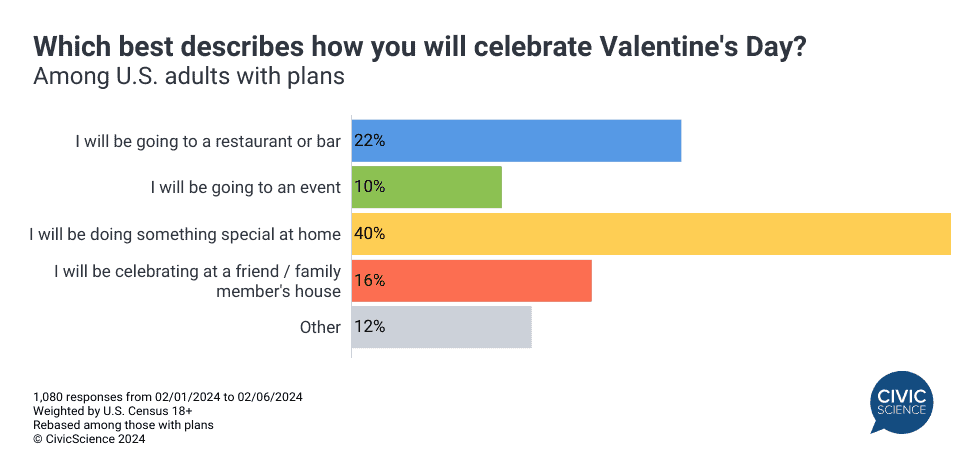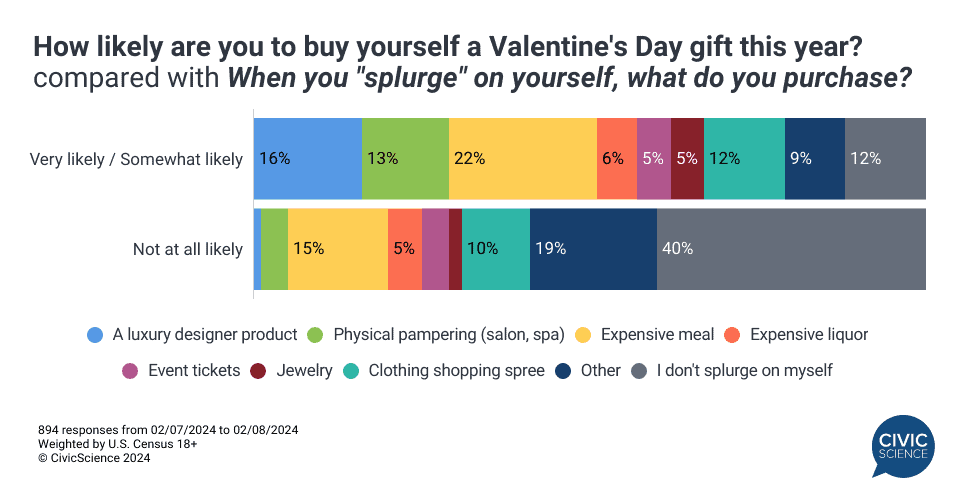With Valentine’s Day just around the corner, it’s time to ask the perennial question – what will this year’s celebrations hold? Last year saw a rise in self-gifting, with women celebrating non-romantic love on a wider scale. But has that continued into 2024? The latest CivicScience data paint a picture of what to expect this year.
Americans Are Celebrating at Home
This year, 50% of U.S. adults have Valentine’s Day plans, up from 48% last year. Among those who do plan to celebrate the day, the largest percentage (40%) will be doing something special at home, while 22% will be going to a restaurant or bar. This year, more people plan to celebrate with friends and family or head to an event compared to last year.

Additional data show nearly two-thirds of Americans plan to purchase a Valentine’s Day gift. Given the plans to keep celebrations lower-key, it comes as no surprise that candy and chocolate top the list for what Americans will be buying to commemorate the day, followed by flowers.
Join the Conversation: Do you already have Valentine’s Day plans for this year?
Self-Gifting Is On the Rise
As compared to 2023, the percentage of women who are planning to buy themselves a gift this year has jumped yet again. Last year, 31% of women were at least ‘somewhat’ likely to purchase themselves a Valentine’s Day gift, while this year 40% say the same.

Currently, 40% of women who are ‘very likely’ to buy themselves gifts this year identify as single, never married, while 40% are married – suggesting a continued trend of women opening their wallets for themselves this year.
But women aren’t the only ones who will be self-gifting. CivicScience data find that 35% of men also say they may be treating themselves to a Valentine’s Day gift – and 16% indicate they are ‘very’ likely to do so.
How Will They Splurge?
The data further indicate that those who are going to buy themselves a Valentine’s Day gift are no strangers to “splurging” on themselves. The most common splurge is an expensive meal (22%), followed by a luxury designer product (16%) and physical pampering (13%), which offers an idea of how self-gifters might spend on themselves for the holiday.

This may be due in part to the fact that those with plans to self-gift this Valentine’s Day are much better off financially than they were before the pandemic – continuing a trend from last year’s report. Nearly 1-in-2 say they are better off now, compared to roughly 1-in-4 who will not be buying themselves a gift.
However, those who are most likely to buy themselves a Valentine’s Day gift have also felt the most stressed recently. So while they’re feeling the pressure, they may also have the money to help navigate it.

Despite the fact that 41% of U.S. adults feel neutral about the holiday, the rise in women purchasing gifts for themselves – and single women in particular celebrating on their terms – is certainly a strong signal that the day is far from being a wash. Instead, companies may find that adjusting their marketing to reach the growing number of self-gifters and stay-at-home celebrators gives a boost to their bottom line.
Take Our Poll: What is your go-to food item to gift on Valentine’s Day?
Interested in additional retail spending insights like these? Contact us to see how the CivicScience InsightStore™ can help retailers navigate the changing consumer landscape with forward-looking data.
If you’re a reporter looking for insights for your content, contact us here.








